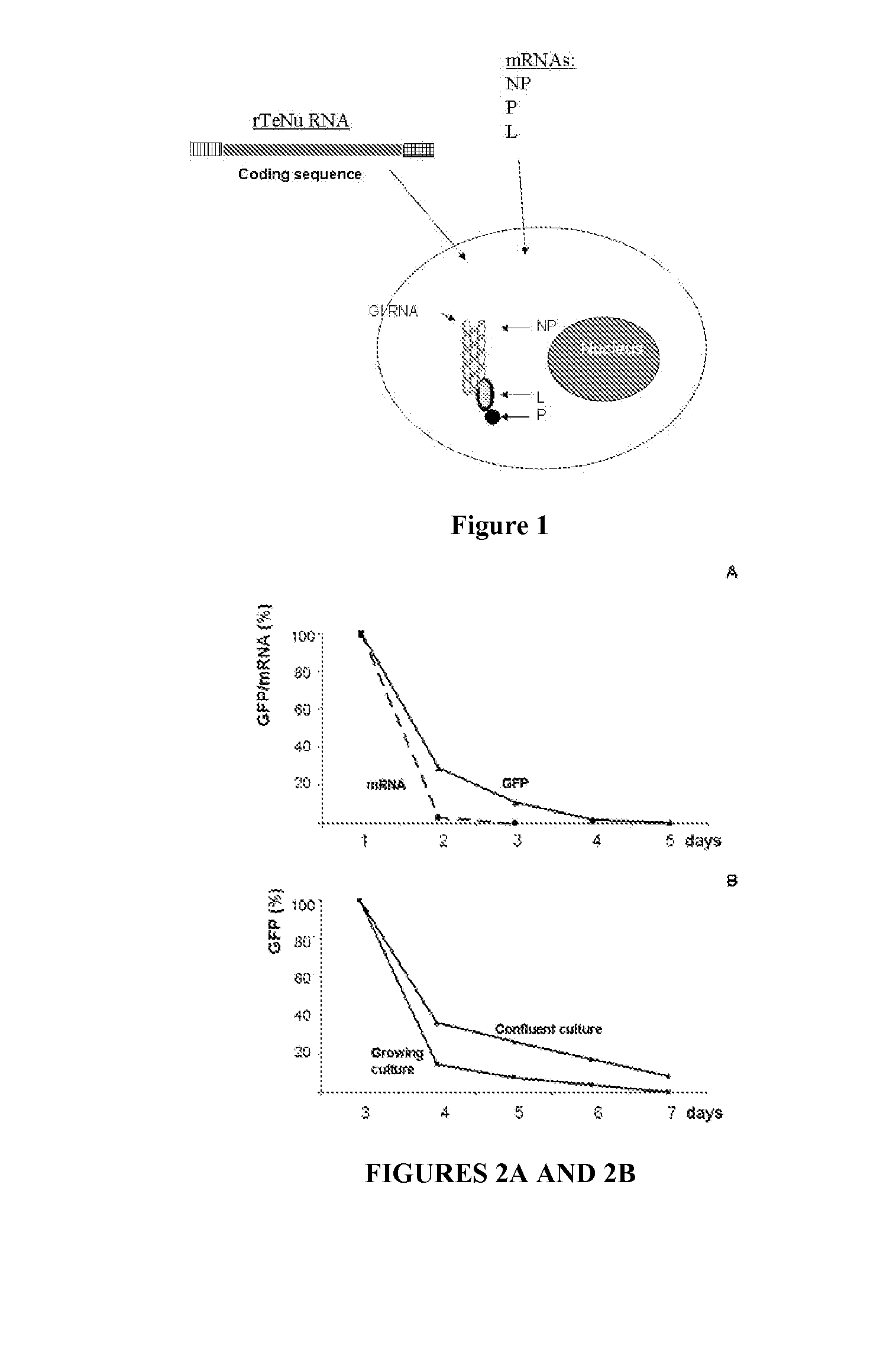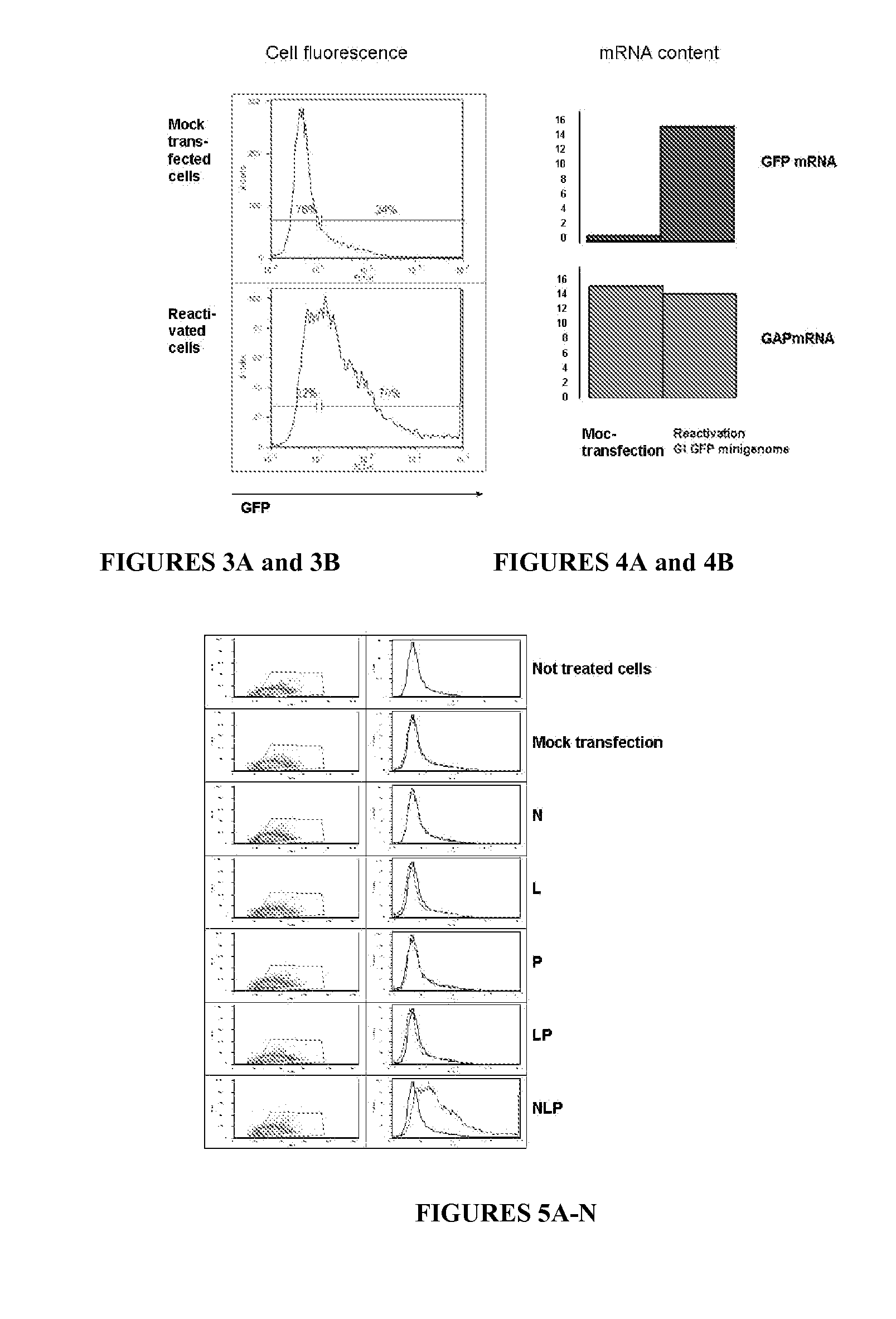Compositions and Methods for Transient Expression of Recombinant RNA
a technology of rna and rteun, which is applied in the field of compositions and methods for transient expression of rna, can solve the problems of increasing burden, affecting the current technology of mrna transfection, and affecting so as to enhance the delivery of rteun to a cell, modulate cell activity, and increase the duration of protein expression of template rna
- Summary
- Abstract
- Description
- Claims
- Application Information
AI Technical Summary
Benefits of technology
Problems solved by technology
Method used
Image
Examples
example 1
GFP RNA can be “Rescued” from a “Genomic” RNA Template Unit (rTeUn)
[0281]Materials and Methods
[0282]In this assay, illustrated in FIG. 1, NP, P and L containing plasmids were replaced with “supplemental” NP, P and L mRNAs. Each mRNA contained ARCA Cap, 5′UTR, coding sequence, 3′UTR and polyA tail (˜400 Nu). 105 cells were plated in a 24 well plate, then the four RNAs were applied to the well: GFP TeUn, NP, L and L were introduced in BHK21 cells in different combinations.
[0283]A PCR-produced DNA template contained as “genomic” sequence (5′-3′ direction) the following elements of Sendai virus (SeV) and GFP: T7 promotor, SeV leader, SeV promotor region of N gene, GFP (700 Nu), SeV terminator region of L gene, SeV trailer, hammerhead ribozyme, T7 terminator, PolyA tail.
[0284]The sequence of DNA template:
(SEQ ID NO: 18)taatacgactcactataggaccaaacaagagaaaaaacatgtatggaatatataatgaagtcagacaggattttagggtcaaagtatccaccctgaggagcaggttccagaccctttgctttgctgccaaagttcacgatgcccgccatgaagatcgagtgccgcatcacc...
example 2
GFP RNA can be “Rescued” from an “Anti-Genomic” RNA Template Unit (rTeUn)
[0289]Materials and Methods
[0290]The anti-genomic GFP rTeUn includes the same elements as genomic rTeUn, but in inverse orientation. It contains (3′-5′ direction): T7 promotor SeV trailer, SeV terminator region of L gene, GFP, SeV promoter region of N gene, SeV leader, hammerhead ribozyme, T7 terminator, PolyA tail (100 Nu). The sequence of DNA template:
(SEQ ID NO: 19)taatacgactcactataggaccagacaagagtttaagagatatttattcttttaaattttcttgtcttcttgtaagtttttcttactattgtcatatggataagtccaagacttccaggtaccgcggagcttcgatcgttctgcacgatagggactaaccattattatcgagctcgagatctggcgaatgcgatcggggtcttgaaggcgtgctggtactccacgatgcccagctcggtgttgctgtgcagctcctccacgcggcggaaggcgaacatggggcccccgttctgcaggatgctggggtggatggcgctcttgaagtgcatgtggctgtccaccacgaagctgtagtagccgccgtcgcgcaggctgaaggtgcgggcgaagctgcccaccagcacgttatcgcccatggggtgcaggtgctccacggtggcgttgctgcggatgatcttgtcggtgaagatcacgctgtcctcggggaagccggtgcccaccaccttgaagtcgccgatcacgcggccggcctcgtagcggtagctgaagctca...
example 3
Subsequent Transfection with Additional NP, P and L mRNAs Results in Reactivation of rTeUn
[0295]In clones containing rTeUn RNA, nucleoprotein complexes can be reactivated and visualized by reoccurrence of GFP rTeUn expression via additional transfection with NP, P and L mRNAs.
[0296]Materials and Methods
[0297]BHK21 were transfected with GFP mRNA or rTeUn GFP RNA together with 3 supplemental mRNAs (NP, P and L).
[0298]Results
[0299]Cells transfected with GFP mRNA lost GFP within the first week of growth. Cells transfected with GFP rTeUn kept substantial fluorescence during the duration of the experiment.
[0300]Nine days after transfection with control (GFP mRNA) and anti-genomic GFP rTeUn, cells were retransfected with supplemental mRNAs: N, P and L exactly as was done during first transfection with GFP rTeUn. This additional transfection had no effect on control cells initially transfected with GFP mRNA. However, 75-80% of the fluorescent cells obtained with GFP rTeUn, could be “reactiv...
PUM
| Property | Measurement | Unit |
|---|---|---|
| aerodynamic diameter | aaaaa | aaaaa |
| time | aaaaa | aaaaa |
| stability | aaaaa | aaaaa |
Abstract
Description
Claims
Application Information
 Login to View More
Login to View More - R&D
- Intellectual Property
- Life Sciences
- Materials
- Tech Scout
- Unparalleled Data Quality
- Higher Quality Content
- 60% Fewer Hallucinations
Browse by: Latest US Patents, China's latest patents, Technical Efficacy Thesaurus, Application Domain, Technology Topic, Popular Technical Reports.
© 2025 PatSnap. All rights reserved.Legal|Privacy policy|Modern Slavery Act Transparency Statement|Sitemap|About US| Contact US: help@patsnap.com



